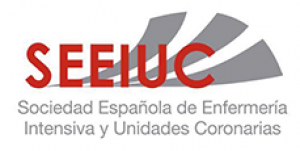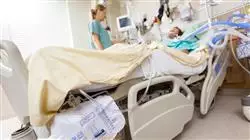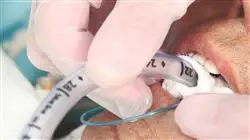University certificate
Scientific endorser

The world's largest faculty of nursing”
Introduction to the Program
Thanks to this University Expert, you will be up to date with progress in the techniques and procedures used by healthcare professionals in the ICU"

The introduction of the latest technological advances in Intensive Care Units is a factor that has led to improved outcomes and survival of patients hospitalized in this area. However, in recent years there has also been a firm commitment to the humanization of the healthcare process, in which the nursing professional plays a decisive role both in the care provided and in the performance of tests and administration of treatments.
This is a reality that leads healthcare professionals to constantly up-to-date their skills and competencies in these units. For this reason, TECH has designed this 100% online university degree that leads the graduate to an effective up-to-date in Nursing in the Intensive Care Unit.
It is a unique program due to its advanced and up-to-datecontent, as well as the pedagogical tools provided by this academic institution to facilitate this updating process. In this way, in only 6 months the nurse will become aware of the organization and management of the ICU, the current role of the nursing professional, the techniques of life support management and the procedures used in critical care in patients with respiratory or pediatric disorders.
In addition, thanks to the Relearning method, based on the reiteration of key content throughout the academic pathway throughout the academic itinerary, the graduate will not have to invest a large number of hours in study and memorization. A system that further facilitates this knowledge of knowledge updating.
In addition, this university proposal has been conceived to respond to the needs of professionals in the health sector. Students only need a device Digital with an Internet connection to be to visualize, at any time, the contents hosted on the virtual platform. Undoubtedly, an ideal option to combine work and personal responsibilities with a quality University Expert.
An unparalleled academic option that will take you through a complete update in Intensive Care Unit Nursing in 6 months"
This Postgraduate diploma in Intensive Care Unit Nursing contains the most complete and up-to-date scientific program on the market. The most important features include:
- Practical cases presented by experts in Intensive Care Nursing
- The graphic, schematic, and practical content with which they are created, provide scientific and practical information on the disciplines that are essential for professional practice
- Practical exercises where the self-assessment process can be carried out to improve learning
- Its special emphasis on innovative methodologies
- Theoretical lessons, questions to the expert, debate forums on controversial topics, and individual reflection assignments
- Content that is accessible from any fixed or portable device with an Internet connection
Clinical case studies will allow you to get a much more direct insight into the most effective procedures for oxygen therapy, thoracentesis and chest drains"
The program includes in its teaching staff professionals from the sector who bring to this program the experience of their work, as well as recognized specialists from leading societies and prestigious universities.
The multimedia content, developed with the latest educational technology, will provide the professional with situated and contextual learning, i.e., a simulated environment that will provide immersive education programmed to learn in real situations.
This program is designed around Problem-Based Learning, whereby students must try to solve the different professional practice situations that arise throughout the program. For this purpose, students will be assisted by an innovative, interactive video system created by renowned and experienced experts.
The best experts in Intensive Care Units will introduce you to nursing management today"

Thanks to the Relearning method, used by TECH, you will be able to focus your attention on the most important concepts"
Why study at TECH?
TECH is the world’s largest online university. With an impressive catalog of more than 14,000 university programs available in 11 languages, it is positioned as a leader in employability, with a 99% job placement rate. In addition, it relies on an enormous faculty of more than 6,000 professors of the highest international renown.

Study at the world's largest online university and guarantee your professional success. The future starts at TECH”
The world’s best online university according to FORBES
The prestigious Forbes magazine, specialized in business and finance, has highlighted TECH as “the world's best online university” This is what they have recently stated in an article in their digital edition in which they echo the success story of this institution, “thanks to the academic offer it provides, the selection of its teaching staff, and an innovative learning method aimed at educating the professionals of the future”
A revolutionary study method, a cutting-edge faculty and a practical focus: the key to TECH's success.
The most complete study plans on the university scene
TECH offers the most complete study plans on the university scene, with syllabuses that cover fundamental concepts and, at the same time, the main scientific advances in their specific scientific areas. In addition, these programs are continuously being updated to guarantee students the academic vanguard and the most in-demand professional skills. In this way, the university's qualifications provide its graduates with a significant advantage to propel their careers to success.
TECH offers the most comprehensive and intensive study plans on the current university scene.
A world-class teaching staff
TECH's teaching staff is made up of more than 6,000 professors with the highest international recognition. Professors, researchers and top executives of multinational companies, including Isaiah Covington, performance coach of the Boston Celtics; Magda Romanska, principal investigator at Harvard MetaLAB; Ignacio Wistumba, chairman of the department of translational molecular pathology at MD Anderson Cancer Center; and D.W. Pine, creative director of TIME magazine, among others.
Internationally renowned experts, specialized in different branches of Health, Technology, Communication and Business, form part of the TECH faculty.
A unique learning method
TECH is the first university to use Relearning in all its programs. It is the best online learning methodology, accredited with international teaching quality certifications, provided by prestigious educational agencies. In addition, this disruptive educational model is complemented with the “Case Method”, thereby setting up a unique online teaching strategy. Innovative teaching resources are also implemented, including detailed videos, infographics and interactive summaries.
TECH combines Relearning and the Case Method in all its university programs to guarantee excellent theoretical and practical learning, studying whenever and wherever you want.
The world's largest online university
TECH is the world’s largest online university. We are the largest educational institution, with the best and widest online educational catalog, one hundred percent online and covering the vast majority of areas of knowledge. We offer a large selection of our own degrees and accredited online undergraduate and postgraduate degrees. In total, more than 14,000 university degrees, in eleven different languages, make us the largest educational largest in the world.
TECH has the world's most extensive catalog of academic and official programs, available in more than 11 languages.
Google Premier Partner
The American technology giant has awarded TECH the Google Google Premier Partner badge. This award, which is only available to 3% of the world's companies, highlights the efficient, flexible and tailored experience that this university provides to students. The recognition as a Google Premier Partner not only accredits the maximum rigor, performance and investment in TECH's digital infrastructures, but also places this university as one of the world's leading technology companies.
Google has positioned TECH in the top 3% of the world's most important technology companies by awarding it its Google Premier Partner badge.
The official online university of the NBA
TECH is the official online university of the NBA. Thanks to our agreement with the biggest league in basketball, we offer our students exclusive university programs, as well as a wide variety of educational resources focused on the business of the league and other areas of the sports industry. Each program is made up of a uniquely designed syllabus and features exceptional guest hosts: professionals with a distinguished sports background who will offer their expertise on the most relevant topics.
TECH has been selected by the NBA, the world's top basketball league, as its official online university.
The top-rated university by its students
Students have positioned TECH as the world's top-rated university on the main review websites, with a highest rating of 4.9 out of 5, obtained from more than 1,000 reviews. These results consolidate TECH as the benchmark university institution at an international level, reflecting the excellence and positive impact of its educational model.” reflecting the excellence and positive impact of its educational model.”
TECH is the world’s top-rated university by its students.
Leaders in employability
TECH has managed to become the leading university in employability. 99% of its students obtain jobs in the academic field they have studied, within one year of completing any of the university's programs. A similar number achieve immediate career enhancement. All this thanks to a study methodology that bases its effectiveness on the acquisition of practical skills, which are absolutely necessary for professional development.
99% of TECH graduates find a job within a year of completing their studies.
Postgraduate Diploma in Intensive Care Unit Nursing
To train Nursing professionals regarding the hospital area that provides Intensive Care Medicine, at TECH Global University we have a Postgraduate Diploma in Nursing in the Intensive Care Unit Intensive Care Unit (ICU). Our objective is to study the specialized technology with which ICUs work, patients with serious health conditions and the constant monitoring of vital signs. In this way, our students will be able to care for critically ill patients, whose pathophysiological alterations have reached such a high level of severity that they represent a potential threat to their lives and, at the same time, are susceptible to recovery.
The best Postgraduate Diploma in critically ill patients
The TECH postgraduate Postgraduate Diploma has the scientific endorsement of the Spanish Society of Intensive Nursing and Coronary Units, so it represents a program of the highest educational quality and an essential training opportunity for professionals. Likewise, we have the most up-to-date thematic content, since we address knowledge regarding the latest technology for life support and new drugs for critically ill patients. Finally, we study other related concepts such as the most frequent cardiorespiratory pathologies in the ICU, critical care in patients with neurological disorders, and psychosocial aspects in Intensive Surveillance Units, among others.







